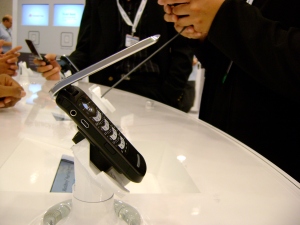You have no doubt read the press releases from Adobe Systems about its CS4 software for mobile content creators and you’ve probably heard of Adobe’s Open Screen project. If you’re a mobile content creator, should you care? MobilizedTV says Yes and explains why below.
Adobe’s Open Screen launched in May, the result of five years of work to get Flash onto devices of all types, from mobile phones to ATM machines, says Anup Murarka, Adobe’s director of technical marketing for Mobile and Device. “What we’ve seen across over 800 million deployments are two industry goals or common challenges that the Open Screen project is trying to address: the first is enabling web browsing and rich internet applications across a broad range of devices and desktops,” he says. “The second–and one we hear most clearly from our developers–has been to give them opportunities to enable them to publish and deliver content and applications across screens more easily than they can today.”
“It’s almost trivial to publish content on the web today,” he notes. “We’d like to bring some of that ease of publishing and distribution to the device industry.”
Murarka spoke about “two use cases” for Flash. the first for stand-alone applications and the second for web browsing. Stand-alone applications relies on AIR, the technology Adobe launched on the desktop for building desktop applications. “If you want to build an application that uses all the same web technologies you’re used to but deliver it outside the browser, AIR enables this,” he says. “An application installer allows developers to ship a binary that installs exactly the same way on Mac, Windows and the beta of Linux as well. We’re going to take that same packaging format and work with different device partners to enable that as well, so you’ll have the same application binaries installable on devices, not just desktops.”
“One of the biggest gaps we have between Flash on the desktop and on a mobile devices is a difference in the scripting language,” he continues. “On the desktop, we support Active Script 3 and in mobile, we’re only at Active Script 2. We’re working with Mozilla on an open source project to get that script working well for devices, essentially bringing the scripting language up-to-date.”
The second element to the standalone application is support for hardware acceleration. “Clearly mobile devices don’t have the same processing power,” he says. “There’s often a ten times difference, and for the high end of those categories. a lot more has to be done. A lot of our energy has been focused on taking advantage of all hardware features to accelerate the graphics capabilities of Flash. We believe we can support AIR on a fairly wide range of phones, from high-end smart phones all the way to mass market feature phones.”
What will this mean for the content creator? “It gets back to the idea that developers/designers used to using web technologies can use the same skillsets and deliver applications not dependent on a browser to a wider range of devices than they’ve been able to.”
The second use case–which builds off the first–is web browsing. “Mobile browsers have become more powerful and capable,” says Murarka. “We’re working to enable a complete web experience on high-end mobile devices. We still won’t see web compatibility on low-end devices, but we do believe, based on several months of engineering work, that we can get desktop-compatible browsers working on smart phones. We’ll need the same hardware acceleration and script browser, but it would live inside the browser. We’re working with partners so that all those browsers will be updated to support Flash.”
A great example of this is our work with Nokia on the Nokia E71 with a browser that actually had a Flash plug-in and could browse existing web content. “The E71 is a first attempt between our two companies to get that web compatibility working well,” he says. “We’re going to continue to work on it. With Open Screen, we hope to release something that’s 100 percent compatible with web content. It’ll take a lot of effort and it’ll take a while and it won’t be on all phones, but we believe we can do it with the high-end smart phone.”
Adobe has also been successful at creating a suite of well-known software tools for content creators, including Photoshop, Flash and Dreamweaver. Creative Suite 4 (CS4) focuses on the broader workflow, from planning through management of assets and metadata all the way through delivery.
Carol Linburn, Adobe group product manager, for mobile authoring, describes how CS4’s Device Central helps mobile content creators. “Particularly relevant for mobile is the explosion of new devices and the number of screens people are targeting,” she says. “The major brands are thinking how they can move content across these screens. RIght now, there is a lot of additional testing and complexity with piping out content in all these different ways and formats. There’s a lot of versioning of content, and it’s more complex and harder to get started.” To keep content developers abreast of where their content might be headed, every time you open CS4, it will show a window of newly shipped devices.
Testing and optimizing is a “huge time sink,” says Lindburn, and Device Central is aimed at shrinking that. “We’re doing some interesting things around automating the testing process,” she says. “Instead of a developer going device by device, they can set up a test script and set it up for 50 to 100 devices. Then they can see the 10 phones where their content isn’t running correctly, go in and diagnose the problem.”
“Automated testing is moving from a world where you have to test everything individually, to a position where you can create a test script to interact with the content and capture keystroke interactions, which can be shared with different developers,” says Lindburn. “You can use that as a way to batch test and not have to test sequentially. You can test simultaneously and you get visual output [snapshots] and error messages that might occur for different devices. We can also adjust latency and so on to give the developer a chance to see what the content looks like on a slower or faster network.”
Another challenge addressed by the new Adobe software focuses on how to showcase content for clients. “If you’re in LA and your client is in NY, and you’re targeting a Nokia N95, but the client doesn’t have one, you have to FedEx one across the country,” she says. “This isn’t conducive to the design process, which is iterative.”
To showcase content to clients, Adobe has added two things: Device Central will spit out a quick storyboard that can be saved to an HTML file that’s easy to share. Likewise, the content creator can capture a video recording and save it as a Quicktime file for people to view. “The person viewing the content doesn’t even need CS4 installed, so it’s a much easier way to share content with a broader audience,” says Lindburn.
She also states that Adobe looked at how to get Flash designers used to building for the web to bridge to the mobile platform. That problem is addressed by Device Central, which is already integrated with the toolset those Flash animators are already using. “It allows them to preview their work on a variety of devices and a range of media types within the same environment,” she says.
“The other piece to get people started is an easier way to manage mobile projects,” says Lindburn. “There is complexity with keeping all the assets together and CS4 offers project management capability. How do I get my files to a phone? You might have different publishing routines or “output tasks” and I can set them up and do it with a single click.” Adobe has also built an SDK (software development kit) for partners to plug into Device Central directly with their different packaging routines.















